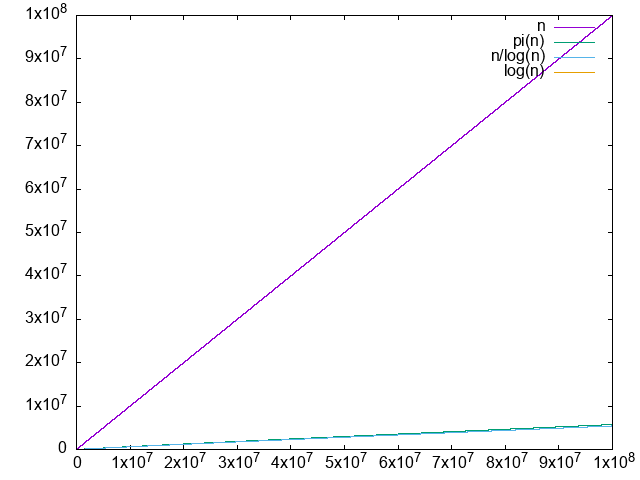Convex hull of all (Cartesian product power) D-tuples, e.g. in 3D:
( 1, 1, 1)
( 1, 1, -1)
( 1, -1, 1)
( 1, -1, -1)
(-1, 1, 1)
(-1, 1, -1)
(-1, -1, 1)
(-1, -1, -1)Basically the same as classical mechanics.
Consider this is a study in failed computational number theory.
The approximation converges really slowly, and we can't easy go far enough to see that the ration converges to 1 with only awk and primes:Runs in 30 minutes tested on Ubuntu 22.10 and P51, producing:
sudo apt intsall bsdgames
cd prime-number-theorem
./main.py 100000000. It is clear that the difference diverges, albeit very slowly.
. We just don't have enough points to clearly see that it is converging to 1.0, the convergence truly is very slow. The logarithm integral approximation is much much better, but we can't calculate it in awk, sadface.
But looking at: en.wikipedia.org/wiki/File:Prime_number_theorem_ratio_convergence.svg we see that it takes way longer to get closer to 1, even at it is still not super close. Inspecting the code there we see:so OK, it is not something doable on a personal computer just like that.
(* Supplement with larger known PrimePi values that are too large for \
Mathematica to compute *)
LargePiPrime = {{10^13, 346065536839}, {10^14, 3204941750802}, {10^15,
29844570422669}, {10^16, 279238341033925}, {10^17,
2623557157654233}, {10^18, 24739954287740860}, {10^19,
234057667276344607}, {10^20, 2220819602560918840}, {10^21,
21127269486018731928}, {10^22, 201467286689315906290}, {10^23,
1925320391606803968923}, {10^24, 18435599767349200867866}};Direct consequence of Euclid's formula.
They sent one of the rare spams Ciro actually was interested in!!! Likely going down lists of top Stack Overflow users.
They have some kind of cryptocurrency, TCHME token, as a reward. Ciro wonders if the value of TCHME will ever be high enough to serve as a valid incentive.
Also, what is the total TCHME supply? Can the website devs issue as much as they want? They do giveaways e.g. as shown at: twitter.com/TeachMeAsap/status/1621353671840899072
And a centralized system with a certralized marketplace would work just as well for the initial phases. But fair play, the idea is interesting.
- phys.org/news/2023-02-muon-detectors-remotely-3d-image.html Using muon detectors to remotely create a 3D image of the inside of a nuclear reactor (2023)
There are unlisted articles, also show them or only show them.


